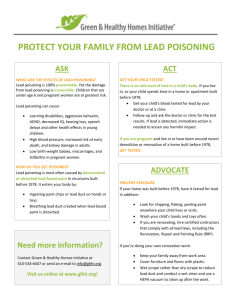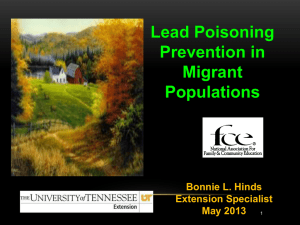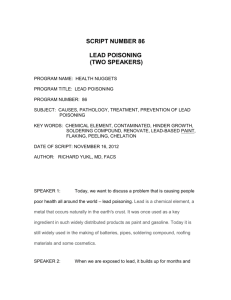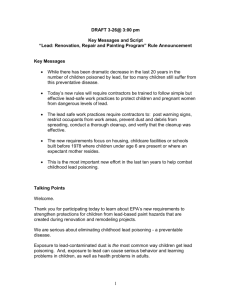script number 86 lead poisoning (one speaker)
advertisement
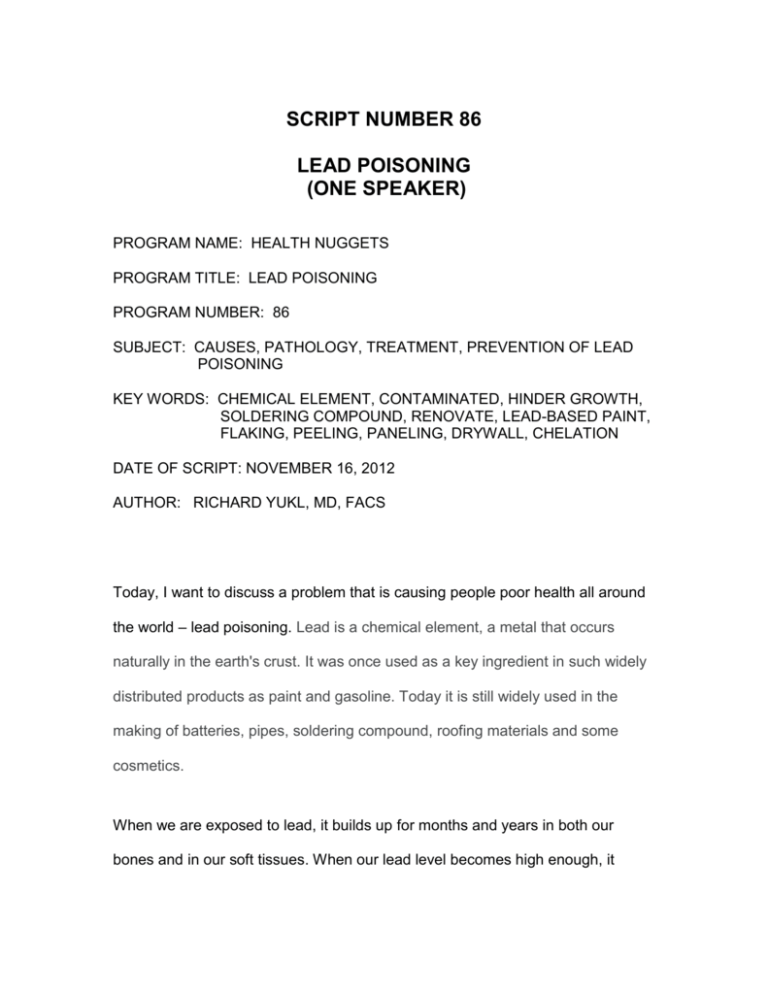
SCRIPT NUMBER 86 LEAD POISONING (ONE SPEAKER) PROGRAM NAME: HEALTH NUGGETS PROGRAM TITLE: LEAD POISONING PROGRAM NUMBER: 86 SUBJECT: CAUSES, PATHOLOGY, TREATMENT, PREVENTION OF LEAD POISONING KEY WORDS: CHEMICAL ELEMENT, CONTAMINATED, HINDER GROWTH, SOLDERING COMPOUND, RENOVATE, LEAD-BASED PAINT, FLAKING, PEELING, PANELING, DRYWALL, CHELATION DATE OF SCRIPT: NOVEMBER 16, 2012 AUTHOR: RICHARD YUKL, MD, FACS Today, I want to discuss a problem that is causing people poor health all around the world – lead poisoning. Lead is a chemical element, a metal that occurs naturally in the earth's crust. It was once used as a key ingredient in such widely distributed products as paint and gasoline. Today it is still widely used in the making of batteries, pipes, soldering compound, roofing materials and some cosmetics. When we are exposed to lead, it builds up for months and years in both our bones and in our soft tissues. When our lead level becomes high enough, it becomes poisonous to our body. We develop lead poisoning. Lead poisoning can be hard to detect in its early stages. Symptoms usually don't appear until dangerous amounts have accumulated. People who seem perfectly healthy can have high levels of lead in their blood. When symptoms do appear in adults, they include memory loss, headaches along with mood disorders, high blood pressure, muscle weakness and pain, along with numbness and tingling of the hands and feet. Of great concern is the fact that lead poisoning can seriously harm children and even unborn babies. Children under the age of 6 are especially in danger of being harmed by lead because their bodies are still developing. Even small amounts of lead can hinder their physical growth, as well as delay their mental development. Sadly, lead can damage a child’s brain and nervous system, and the damage is irreversible. Aside from brain damage, other symptoms of lead poisoning in children include irritability, a loss of appetite, belly pain along with vomiting and constipation, weight loss and extreme tiredness. Extremely high lead levels can cause seizures, unconsciousness and even death. The use of lead in paint has been banned in countries such as the United States and England since 1978, but it is still added to paint in some countries, and it remains common in our environment. Even in countries where it can no longer be added to new paint, lead-based paint can still be found on the painted walls and woodwork of many older homes. Additionally, lead pipes, brass plumbing fixtures and copper pipes soldered with lead can release lead particles into tap water, and household dust can contain lead from old and flaking lead paint, or from contaminated soil brought in from outdoors. Today, the most common source of lead exposure in adults comes from living in a house whose walls are painted with lead-based paint, and from the house dust of older buildings that have been contaminated with lead. Adults who work with batteries, who renovate old homes or who work in auto repair shops can also become contaminated. Most lead poisoning in children results from the child eating flakes of lead-based paint that have peeled off the walls, and toys made with lead-based paint. Children eat them because they taste sweet. Doctors can diagnose lead poisoning using a simple blood sample taken from a finger or from a vein. A lead blood level can be measured directly. The most important thing to remember about the dangers of lead poisoning is that we must protect our children. Even though people of any age, race, or economic level can get lead poisoning, children are at the greatest risk. They are more likely to absorb lead because they place their hands and toys painted with lead-based paint into their mouths, and, tragically, the lead can permanently damage their developing brain and nervous system, causing serious problems with language and intelligence. Protection against the harmful effects of lead depends, to a great degree, on the prevention of lead exposure. Both adults and children who have relatively low levels of lead elevation in their bodies can lower those levels, in time, to a safer range by simply avoiding further lead exposure. The first step is to remove all possible sources of contamination. Even if it is not possible to remove all the lead from your environment, you can do some things to lower your exposure to it. For example, you may not be able to remove all of the old lead-based paint from your house, but you can at least seal it in. Don’t attempt to remove the lead-based paint by sanding, because that creates large amounts of small particles. And, don’t remove the old paint using an open-flame torch, because the flame produces lead particles small enough to breathe into your lungs. If the paint is not flaking and peeling, just paint over it with modern paint that does not contain lead, or cover the walls with new paneling or drywall sheets Other simple measures that you can take to help protect yourself and your family from lead poisoning include hand washing. Washing your children's hands after they play outdoors, before they eat and at bedtime will help to reduce their handto-mouth transfer of contaminated dust and soil. Also, cleaning your floors with a wet mop and wiping your furniture, windowsills and other dusty surfaces with a damp cloth helps. If your house has older plumbing containing lead pipes or fittings, run your cold water for at least a minute before using it, and don't use hot tap water to make baby formula and for cooking. Your local government health department can recommend other ways to identify and reduce lead sources in your home and in your community. If you have suffered severe lead contamination, you may need medical treatment called chelation therapy. Your doctor will give you a medicine that will combine with the lead present in your blood, allowing your body to remove it by passing it through your urine. Unfortunately, it will not be possible to reverse damage that has already occurred. Health Nuggets is written by Dr. Richard Yukl, a medical doctor working in the United States. The medical views expressed in this program are his and may differ for your particular health needs. If you need medical advice, please consult a medical professional in your area.
